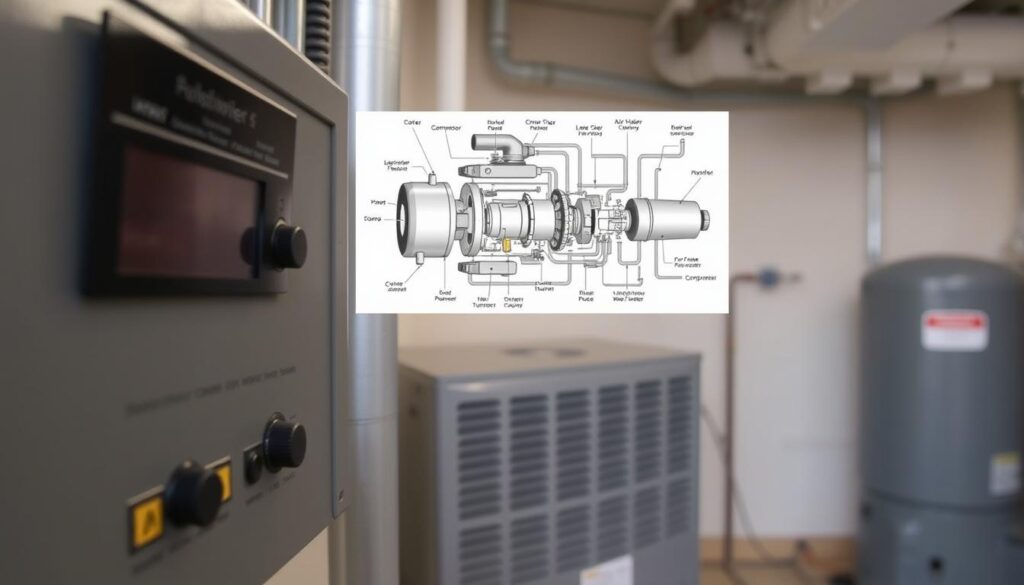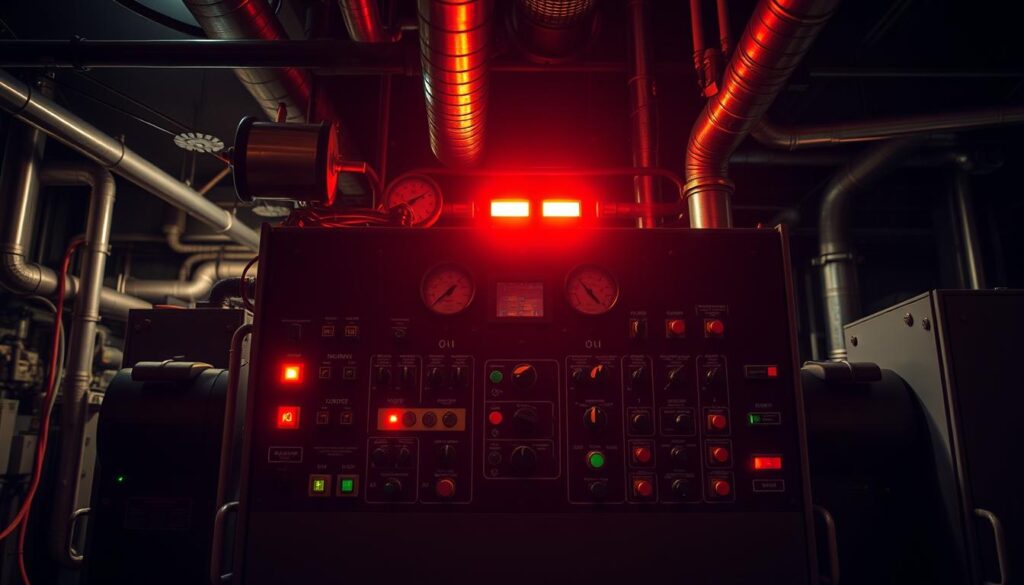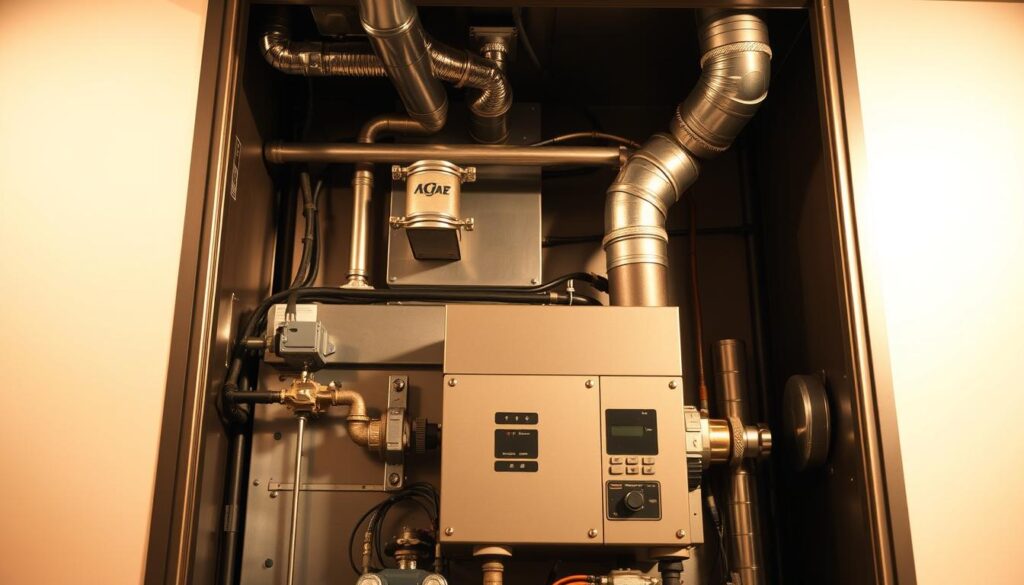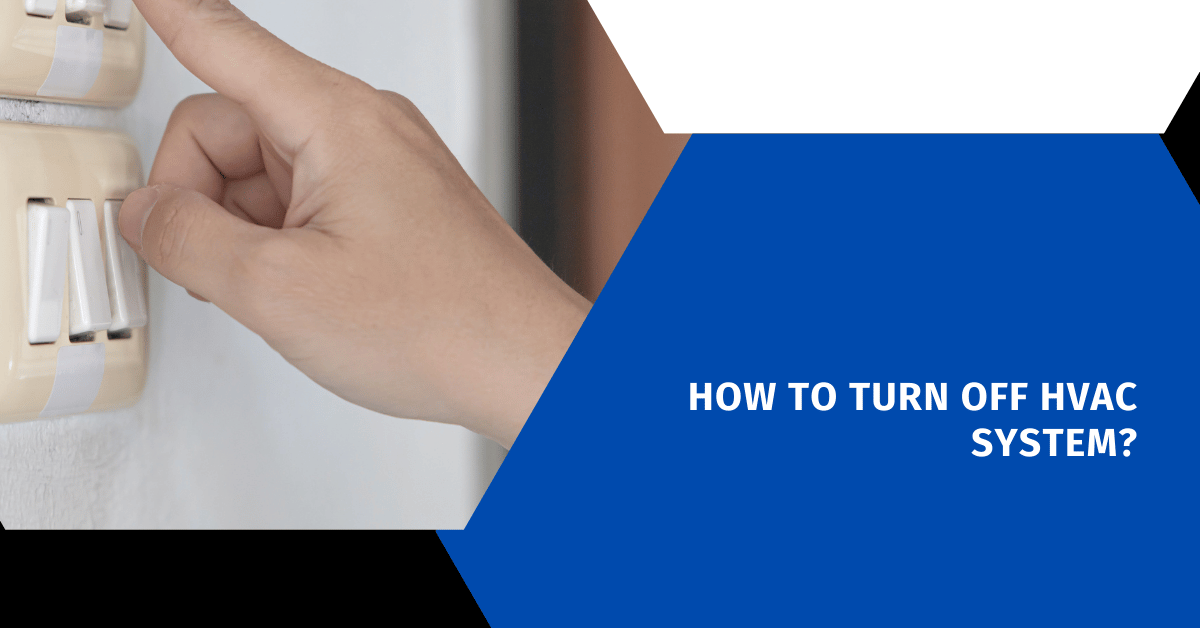How to Turn Off HVAC System? Ever thought about how to safely turn off your heating and cooling systems? It might seem easy, but there’s more to it than just flipping a switch.

Learning to shut down your HVAC system involves knowing the right steps and the risks. Whether you’re getting ready for maintenance, leaving town, or dealing with a problem, the correct shutdown can save time and avoid damage.
This guide will show you how to safely power down your HVAC system. You’ll learn from using your thermostat to finding external disconnect switches. You’ll get the knowledge to handle your HVAC equipment with confidence.
Key Takeaways
- Multiple methods exist for turning off an HVAC system
- Safety should always be your primary concern during shutdown
- Different systems require specific shutdown procedures
- Regular maintenance helps prevent unexpected system failures
- Professional guidance is recommended for complex HVAC issues
Table of Contents
Understanding When to Shut Down Your HVAC System
Knowing when to shut down your HVAC system is key to protecting your home’s cooling system and keeping you safe. Your HVAC system sends out warning signs that you should never ignore.
Critical Signs Your System Needs Shutdown
Knowing when to shut down your HVAC system can prevent serious damage and safety risks. Look out for these key signs:
- Unusual grinding or scraping noises
- Burning electrical odors
- Visible refrigerant or water leaks
- Consistently poor cooling performance
- Unexpected system freezing or ice formation
Safety Considerations Before Shutdown
Before shutting down your HVAC system, remember these important safety steps:
- Turn off the system at the thermostat first
- Disconnect power at the circuit breaker
- Avoid touching any electrical components
- Wear protective gloves if investigating issues
Emergency Situations Requiring Immediate Shutdown
Certain situations need you to shut down your HVAC system right away to avoid dangers:
| Emergency Scenario | Recommended Action |
|---|---|
| Electrical burning smell | Immediate shutdown and professional inspection |
| Strange loud mechanical sounds | Stop system and contact HVAC technician |
| Smoke or sparking | Cut power and call emergency services |
Remember, your safety always comes first. If unsure, shut down and get professional help.
Using Your Thermostat to Power Down the System
Turning off your home’s air conditioning system needs careful steps. Your thermostat controls the indoor temperature and system operation. Knowing how to turn off the air conditioning helps save energy and avoid damage.
Thermostats come in different types, each with its own way to shut down the HVAC system. Modern digital and smart thermostats offer more options than older models.
- Digital thermostats have a simple system off button
- Smart thermostats let you shut down remotely with mobile apps
- Mechanical thermostats need manual mode switching
To turn off your thermostat controls, follow these steps:
- Find the main system control switch on your thermostat
- Switch between “heat,” “cool,” and “off” settings
- Make sure the system is fully powered down
| Thermostat Type | Shutdown Method | Complexity |
|---|---|---|
| Mechanical | Manual switch | Low |
| Digital | Button control | Medium |
| Smart | App or voice command | High |
Turning off your home’s air conditioning is more than just switching modes. Make sure you know how to shut down your specific thermostat to avoid system problems.
Explore Our HVAC Shop
Looking for top-rated HVAC tools, parts, and accessories? Visit our shop and find the perfect solution for your needs.
Visit the ShopLocating and Using the External Disconnect Switch
Knowing how to use the HVAC power disconnect switch is key when you’re working on your central air system. This switch is a vital safety feature for your air conditioning unit.
Your outdoor AC condenser unit has a special electrical safety component. It lets you quickly shut down power. This small but important switch is usually found on an exterior wall near the unit.
Finding the Outdoor Disconnect Switch
Finding the disconnect switch is easy. Look for a small metal box near your outdoor air conditioning unit. This box is usually:
- Mounted on the exterior wall
- Within 3-5 feet of the AC condenser
- Approximately 4-6 feet from the ground
- Typically gray or metal in color
Proper Switch Operation Procedure
To safely power down your central air system, follow these steps:
- Approach the disconnect switch carefully
- Open the metal cover
- Identify the on/off or pull-out mechanism
- Pull the switch to the “off” position
- Confirm the switch is fully disengaged
Verifying Complete Shutdown
After using the HVAC power disconnect, make sure the system is fully powered off. Check that:
- No fan or compressor sounds are present
- No electrical activity is visible
- The unit remains completely stationary
Always be careful and consider getting a professional if you’re unsure about any step in the disconnect process.
How to Turn Off HVAC System at the Circuit Breaker
Learning to shut off your furnace system at the circuit breaker is key for HVAC maintenance. Your electrical panel is a safe way to turn off your heating and cooling when other methods fail.
- Wear rubber-soled shoes
- Use a flashlight if it’s dark
- Avoid touching metal parts
- Keep your hands dry
Find your home’s main electrical panel, usually in a basement, garage, or utility room. Look for a breaker marked for your HVAC system or air conditioning unit.
“Safety first: Always approach electrical systems with caution and respect.”
To shut down your HVAC system, follow these steps:
- Open the electrical panel cover carefully
- Find the HVAC system breaker
- Flip the switch to the “off” position
- Check that the system has stopped
If you’re not sure about the breaker, use a circuit tester or check your home’s electrical diagram. When in doubt, call a professional HVAC technician for safe shutdown.
| Breaker Location | Safety Precautions |
|---|---|
| Basement | Wear protective footwear |
| Garage | Keep area dry |
| Utility Room | Use proper lighting |
Remember, turning off your furnace system at the circuit breaker needs care and should only be done when necessary. If you’re unsure or uncomfortable, get help from a professional.
Explore Our HVAC Shop
Looking for top-rated HVAC tools, parts, and accessories? Visit our shop and find the perfect solution for your needs.
Visit the ShopShutting Down Window Units and Portable Systems
Turning off home air conditioning needs special steps for window and portable units. These smaller cooling devices require careful handling during shutdown and storage.
Portable and window air conditioners need special care when you want to turn off the heating and cooling. The right steps can prevent damage and make the unit last longer.
Unplugging Smaller Air Conditioning Units
- Disconnect the unit from the electrical outlet carefully
- Ensure hands are dry before unplugging
- Gently pull the plug straight out to avoid wire damage
- Remove the plug from the wall socket completely
Preparing Units for Storage
Proper storage is key to keeping your air conditioning equipment in top shape.
- Clean the unit thoroughly with a soft cloth
- Remove and wash removable filters
- Dry all components completely to prevent mold
- Cover the unit with a protective dust cover
| Storage Step | Purpose | Recommended Action |
|---|---|---|
| Cleaning | Remove dust and debris | Use soft brush and mild detergent |
| Moisture Removal | Prevent mold growth | Run fan mode for 30 minutes before storage |
| Physical Protection | Prevent dust accumulation | Use breathable protective cover |
Pro tip: Store your portable or window air conditioning unit in a cool, dry place to maintain its condition during inactive periods.
Common Problems That Require System Shutdown

Knowing when to shut down your HVAC system can prevent major damage. Your heating and cooling equipment might show warning signs that need quick action. These signs could mean it’s time to shut down the system.
Some critical problems that need an HVAC emergency shutdown include:
- Unusual grinding or scraping noises from the unit
- Persistent electrical burning smell
- Complete loss of airflow
- Refrigerant leaks around the system
- Frozen evaporator or condenser coils
Understanding why these issues happen is key to safely shutting down your HVAC. Electrical problems are especially dangerous. They can cause fires or make your system fail completely.
| Problem Area | Potential Risks | Recommended Action |
|---|---|---|
| Electrical Components | Potential fire hazard | Immediate system shutdown |
| Refrigerant Leaks | System inefficiency | Professional inspection required |
| Mechanical Failures | Complete system breakdown | Stop operation, call technician |
Your safety is always the top priority. If you’re unsure about your system’s performance, turn off the power. Then, call a professional HVAC technician for a detailed check.
Seasonal HVAC System Deactivation Steps
Getting your HVAC system ready for the seasons is key. It keeps your system running well and saves energy. The shutdown process needs careful steps and planning as the weather changes.
Seasonal changes mean different ways to turn off your heating and cooling. Knowing the right steps helps avoid damage and keeps your system in great shape.
Fall Shutdown Procedures
As fall comes, your HVAC system needs special care for winter. Here are the important steps:
- Clean or replace air filters for better air quality
- Check the outdoor cooling unit for debris and damage
- Cover the outside air conditioning parts to protect them from winter
- Look at the weatherStripping around windows and doors to stop heat loss
Spring Transition Guidelines
When winter ends and spring starts, your HVAC system needs careful startup:
- Book a professional maintenance check
- Clean the air conditioning unit and area
- Test the cooling system before summer gets hot
- Lubricate moving parts to reduce wear
Pro tip: Regular seasonal maintenance can make your HVAC system last longer and work better.
Proper seasonal transition management is key to maintaining a reliable and efficient HVAC system.
Explore Our HVAC Shop
Looking for top-rated HVAC tools, parts, and accessories? Visit our shop and find the perfect solution for your needs.
Visit the ShopEssential Safety Precautions During Power Down
When shutting down HVAC systems, your safety is key. Electrical parts can be very dangerous during shutdown. Knowing the right safety steps can avoid accidents and injuries.
Before you start an HVAC shutdown, remember these important steps:
- Always wear protective electrical safety gear
- Never touch exposed electrical wiring
- Disconnect power sources completely
- Use appropriate personal protective equipment (PPE)
The most important thing is to remove all electrical risks. Electricity can cause severe injury or death if mishandled. Experts say to be very careful with every electrical part.
Important steps for HVAC shutdown safety include:
- Identify and locate main power disconnect switch
- Verify system is completely powered off
- Check for any residual electrical current
- Use non-conductive tools when necessary
If you’re unsure about shutting down an HVAC system, call a professional. Trying complex electrical work without training can be very dangerous.
Post-Shutdown System Checks
After you’ve shut down your HVAC system, it’s crucial to check everything. This ensures your central air system is fully turned off. These checks help avoid damage and keep your home safe.

Verifying Complete Power Disconnection
To make sure your HVAC system is off, you need to inspect it carefully. Here are the key steps to follow:
- Check indoor and outdoor unit electrical indicators
- Inspect circuit breaker position
- Verify thermostat display is blank
- Listen for any unexpected mechanical sounds
Checking for Residual Operation
Some HVAC systems might still seem to be working a bit. Look out for these signs:
- Faint fan motor humming
- Blinking control panel lights
- Slight temperature variations near units
- Unexpected electrical draw
Pro tip: Use a non-contact voltage tester to confirm complete electrical disconnection across all system components.
Thorough verification prevents potential system damage and ensures total system shutdown.
If you notice anything odd during these checks, get a professional HVAC technician. They can help avoid any problems or safety issues.
When to Contact HVAC Professionals
Knowing when to call an HVAC professional can save you from costly repairs and potential system damage. While some maintenance tasks are manageable for homeowners, certain situations demand expert intervention during an hvac maintenance shutdown procedure.
Critical scenarios that require professional assistance include:
- Unusual noises like banging or grinding from the system
- Persistent water leaks around your air conditioning unit
- Electrical complications during hvac emergency shutdown
- Suspected refrigerant leaks
- Mechanical failures beyond basic troubleshooting
Attempting complex repairs without proper training can lead to more significant damage. Professional HVAC technicians have the right tools and skills to fix system issues accurately.
When selecting an HVAC service provider, consider these key factors:
| Qualification | What to Look For |
|---|---|
| Certification | EPA and state-approved licenses |
| Experience | Minimum 5 years in HVAC services |
| Reviews | Positive customer testimonials |
| Emergency Services | 24/7 availability |
Prioritize professionals who understand comprehensive hvac maintenance shutdown procedures and can provide detailed system diagnostics. Your system’s longevity depends on timely and expert maintenance.
Explore Our HVAC Shop
Looking for top-rated HVAC tools, parts, and accessories? Visit our shop and find the perfect solution for your needs.
Visit the ShopMaintaining Your System During Inactive Periods
Proper care during HVAC system downtime is key to keeping it efficient and lasting longer. When you turn off heating and cooling, regular maintenance stops damage and makes it ready for the future.
Your HVAC maintenance shutdown procedure should include several key steps to keep the system in top condition:
- Clean outdoor units thoroughly to remove debris and dust
- Check and replace air filters before storage
- Inspect electrical connections for any signs of wear
- Ensure proper ventilation to prevent moisture buildup
Critical maintenance areas require special attention during inactive periods:
| Maintenance Area | Recommended Action |
|---|---|
| Outdoor Components | Cover with weatherproof protective sheet |
| Electrical Systems | Disconnect power and seal electrical connections |
| Ductwork | Seal openings to prevent pest intrusion |
Professional inspections during inactive periods can catch potential issues early, saving you from costly repairs later. Regular maintenance stops unexpected breakdowns and keeps your HVAC system ready when you need it.
Proactive care is always less expensive than reactive repairs.
Think about getting a professional HVAC technician to do a full system check before you stop using it for a long time. This keeps your system in good shape and gets it ready for when you need it again.
Conclusion
Safely shutting down HVAC systems is important. You need to know how to do it right to avoid damage. This guide helps you manage your home’s climate control.
Knowing when and how to turn off your HVAC is key. This is true for seasonal maintenance, extended non-use, or safety reasons. The methods here are helpful for homeowners. But, for complex issues, always get professional help.
Regular maintenance and smart shutdowns are vital for your system’s health. They help prevent breakdowns, save money, and keep your home comfy. Taking care of your HVAC shows you’re a responsible homeowner.
While you can do many shutdowns yourself, safety always comes first. If unsure, always ask an HVAC expert. Your effort in maintenance will save you time, money, and stress later on.

